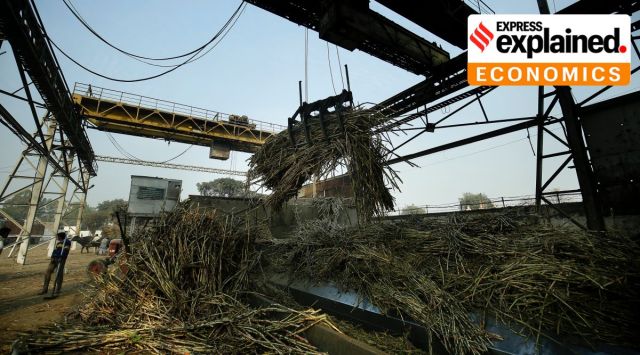- India
- International
Explained: Sugar export curbs and their impact
The government has notified that sugar exports will be restricted, or allowed only with permission. How much sugar does India export, what led to this decision, and what are its likely implications?
 A sugar mill in Shamli, UP. Most millers believe the curbs will not impact targeted exports. (Express Photo: Praveen Khanna, File)
A sugar mill in Shamli, UP. Most millers believe the curbs will not impact targeted exports. (Express Photo: Praveen Khanna, File)The government Tuesday decided to “restrict” the export of sugar, effective from June 1. The curbs, the first such move in four years, have been ordered to maintain “domestic availability and price stability of sugar”, the government said. India is the biggest producer of sugar and the second largest exporter after Brazil. What do these curbs mean for domestic and the international market?
What are the latest curbs?
The government has moved export of sugar from the ‘open category’, which requires no government intervention, to ‘restricted’ category. This means that export of sugar is allowed only with specific permission from the Directorate of Sugar, Department of Food and Public Distribution (DFPD), Ministry of Consumer Affairs, Food & Public Distribution. Also, the curbs come into effect from June 1 and will continue till October 31, or until further orders.
Sugar industry insiders pointed out that unlike wheat, where export has been banned, sugar would continue to be exported, but from June 1, permission would be required to send the shipments out.
Till date, the industry has contracted export orders of 90 lakh tonnes out of which 71 lakh tonnes has been shipped out of the country. From June 1, permission to export would be required for both the pending contracted quantity and any new contracts entered by mills.

How much did India export during the last few seasons?
Thanks to the bumper crops over the last four seasons, exports too boomed. The Centre also extended subsidies to millers to push sales abroad. Before the start of the sugar season (October to September every year), the central government would announce both the quota for export and the subsidy to achieve the target.
In 2017-18, the government set a target to export 20 lakh tonnes of sugar and sanctioned a budget of Rs 1,540 crores to handle internal transport, freight, handling and few other operations. For that season, the industry recorded exports of 6.2 lakh tonnes and with a reported expenditure of Rs 440 crores of the subsidy budget.
For the next season (2018-19), 50 lakh tonnes export target was set with a subsidy budget of Rs 5,538 crores, of which 38 lakh tonnes of sugar was shipped out using R 4,263 crores of the subsidy.
After a bumper crop in 2019-20, export quota was hiked to 60 lakh tonnes with a subsidy budget Rs 6,268 crores. Millers clocked exports of 59.60 lakh tonnes using up Rs 6,225 crores of the subsidy budget.

The traction in the international market helped sugar exports touch 70 lakh tonnes in 2020-21, out of which 60 lakh tonnes was done using Rs 3,500 crores of government subsidy and 10 lakh tonnes was exported without any government aid. The export without government subsidy was done under the open general license regime.
The current season (2021-22) has seen millers enter into contracts to export 90 lakh tonnes of sugar. Out of this, 71 lakh tonnes of sugar has already left the country. The consignments scheduled to leave after June 1 will need government permission.
What also helped exports grow over the last few seasons is the fact that Brazil produced more ethanol than sugar given the exceptional rise in fuel prices. This, and drought hitting other big sugar producers like Thailand helped India venture in countries which otherwise were dependent on Brazilian sugar. India is the second largest sugar producer in the world after Brazil. However, Brazil has always led in terms of exports.
In the current sugar season, international sugar prices have continued to be bullish. Exports have helped millers ensure that farmers are paid on time.
Why the curbs, now?
Exports, industry insiders say, can continue unabated given the international demand. But for the government, a possible worry is low stocks at the beginning of the next season. This can lead to supply constraints for around three months.
The sugar season officially starts in October, but picks up momentum only after December. If there is scarcity of back-up stocks during this period then prices can escalate in the domestic market. At a time when reining in inflation stays a major priority, the government can ill afford that risk.
Retail prices can see inflation if the October opening stock is anything less than 65-70 lakh tonnes. The present curbs would ensure the government keeps a tab on sugar stock real-time to ensure that there is no shortage at the start of the next season. Retail sugar prices have been almost stagnant year-on -year hovering between Rs 39.50 to Rs 41 per kg.
What will be the sugar output this season?
The country has seen a bumper sugarcane crop. Of the 521 mills engaged in cane crushing this season, 116 mills are still operating with Maharashtra leading. It is expected that the crushing season will end in the second week of June for most part of the country.
A few mills in Tamil Nadu and Karnataka are expected to continue crushing till September. The final production figure is still anybody’s guess given the large number of mills in operation, but most in the industry feel the country will see production of 350 lakh tonnes of sugar. Around 34 lakh tonnes of sugar has already been subsumed for production of ethanol. India’s domestic consumption is pegged at 260 lakh tonnes.
What is the industry view on the latest restrictions?
The first reaction to this curb was a Rs 50 per tonne drop in the ex-mill prices, which was on expected lines. International prices have remained more or less the same. Prakash Naiknavare, managing director of the National Cooperative Sugar Factories Federation, believes that India would end up exporting around 100 lakh tonnes of sugar this season even with the curbs. “If the present logistic and port congestion issues are resolved, there would be no problem in reaching this figure,” he said. Most millers said the curbs would not affect them much and exports would continue without hassle.
More Explained
EXPRESS OPINION
Apr 27: Latest News
- 01
- 02
- 03
- 04
- 05










































